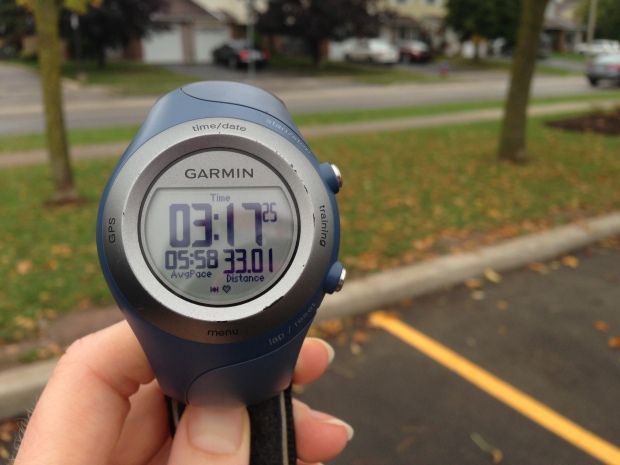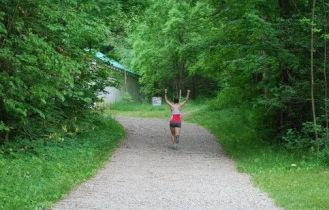Marathon training officially starts today! Fortunately it was pretty easy to get started because Mondays are my off day in my new training plan, so I spent about 40 minutes in the gym doing core work and rolling out my well-rested muscles. Phew!
We’ve already talked about my audacious (isn’t that a fabulous word?) goal to train for my first marathon in 10 weeks and qualify for the Boston Marathon. We’ve already agreed that I’m crazy, so let’s move on to how I plan to make it happen!
Here’s the qualifier – I’m not a new runner. In addition to my other triathlon training, I’ve been running between 35 and 45km/week for most of the summer, and I’ve done at least four long runs 20km or longer in the past two months. Obviously this training plan isn’t for someone just starting out, and I’m not a coach or a doctor so please use discretion if you choose to follow along.
My Audacious 10-week Hamilton Marathon Road2Hope Training Plan:
Week 1: August 26 – September 1 (43km)
Monday – off
Tuesday – 5km easy
Wednesday – 10km intervals
Thursday – spin class
Friday – off
Saturday – 8km distance, spin class
Sunday – 20km long
Week 2: September 2 – September 8 (55km)
Monday – off
Tuesday – 10km distance
Wednesday – 10km intervals
Thursday – spin class
Friday – off
Saturday – Esprit de Montréal, Olympic Duathlon
Sunday – 20km long
Week 3: September 9 – September 15 (47km)
Monday – off
Tuesday – 7km recovery
Wednesday – 10km easy tempo
Thursday – spin class
Friday – 5km recovery
Saturday – spin class
Sunday – 25km long
Week 4: September 16 – September 22 (62km)
Monday – off
Tuesday – 10km distance
Wednesday – 10km intervals
Thursday – spin class
Friday – 5km easy
Saturday – 12km easy with some hills, spin class
Sunday – 25km long/tempo
Week 5: September 23 – September 29 (69km)
Monday – off
Tuesday – 12km distance
Wednesday – 10km intervals
Thursday – spin class
Friday – 5km easy
Saturday – 12km easy, spin class
Sunday – 30km long
Week 6: September 30 – October 6 (55km)
Monday – off
Tuesday – 7km recovery
Wednesday – 10km tempo
Thursday – spin class
Friday – 5km recovery
Saturday – spin class
Sunday – 33km long
Week 7: October 7 – October 13 (67km)
Monday – off
Tuesday – 12km distance
Wednesday – 10km intervals
Thursday – spin class
Friday – 5km easy
Saturday – 15km easy with some hills, spin class
Sunday – 25km long/tempo
Week 8: October 14 – October 20 (62km)
Monday – off
Tuesday – 14km distance
Wednesday – 10km intervals
Thursday – spin class
Friday – 5km easy
Saturday – 12km distance, spin class
Sunday – Scotiabank Toronto Waterfront Half-Marathon, 21.1km at goal race pace
Week 9: October 21 – October 27 (40km)
Monday – off
Tuesday – 10km easy
Wednesday – 10km intervals
Thursday – spin class
Friday – 5km easy
Saturday – spin class
Sunday – 15km easy
Week 10: October 28 – November 3 (63km)
Monday – off
Tuesday – 8km easy with strides
Wednesday – 8km tempo
Thursday – spin class
Friday – 5km easy
Saturday – off
Sunday – Hamilton Marathon Road2Hope, 42.2km
New to this training program is the addition of core work, strength training and roller sessions; every weekday I add about 30 minutes of cross training with core and roller on Monday/Wednesday/Friday, and strength training on Tuesday/Thursday.
Run types:
The key to building strength and speed is to vary the training intensity, which forces your body to adapt to different stimulus and increases your running efficiency. Also, if you want to run fast in racing, you have to run fast in training!
Recovery: it’s impossible to run too slowly during a recovery run; they should be very, very easy.
Long: around 5:45 pace, sustainable effort.
Long/tempo: maintain long run pace for the majority of the run; in the middle 10km, run every second kilometer faster than 5:00 pace (marathon race pace), maintaining long run pace between fast kilometers.
Distance: relatively easy run, pace around 5:30 depending on the day and terrain; some of my distance runs include hill work since my goal race has a significant downhill portion.
Easy: pace around 5:20, medium effort over shorter distances.
Tempo: slightly slower than 10km race pace, around 4:40 based on my 10k PB.
Intervals: these change from week to week, but involve running faster than 10km race pace (4:00 to 4:30) over shorter distances (1600m and shorter). If you’re looking for ideas, check out my running workouts page.
So what are you waiting for? Let’s go run!











